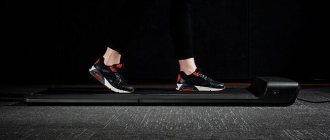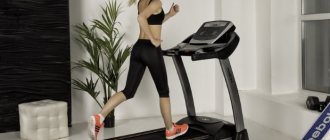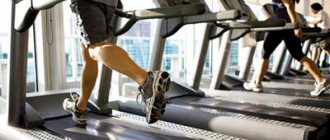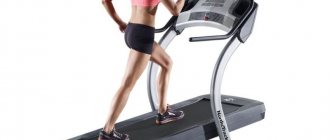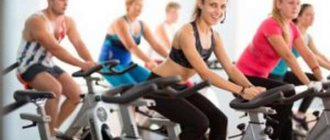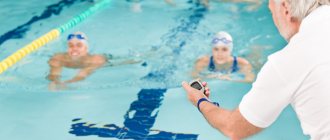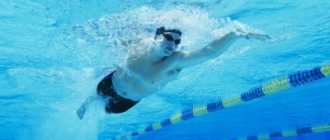The treadmill is an excellent exercise machine that is suitable for all levels of runners: from those just getting into fitness to experienced athletes preparing for serious competitions. Whether you just want to run for health without the limitations of the weather, or you are a keen runner, the track can be used to suit your needs.
However, in order for the exercise machine to be useful, improve your form and give you pleasure, you need to know and follow the rules of how to run on the treadmill. A treadmill helps simulate running outside, but it's not quite the same.
Running on a treadmill has several nuances, but understanding them is not that difficult. We will talk about this and much more in the article.
Features of running technique on a treadmill
By using proper running technique, you can not only improve your running efficiency, but also protect yourself from the injuries that plague runners. Here are a few rules that work when running on a treadmill.
Look straight ahead
Don't look down, nothing will happen under your feet, and lowering your head to follow your eyes puts stress on your neck and upper back. Bending your neck will not only affect your posture, but will also make breathing difficult. Looking at the road surface can also cause dizziness.
Don't slouch
Another mistake people make is slouching their shoulders while running. Keep them relaxed by periodically lowering and shaking your arms.
Keep your back straight
Be sure to keep your body position straight: the treadmill will pull your legs back, but you don't have to lean forward much. Otherwise, you may experience neck and back pain or lose your balance.
Photo: runnersworld.com
Breathe through both your mouth and nose
Beginning runners may read the instructions to breathe through the nose, but the nose will not be able to take in enough air for the stress of running. Moreover, there is not enough oxygen in the rooms, so breathing through the mouth is necessary to fully satisfy the body's needs.
Don't put your foot too far forward
Watch where you step as you land. Ideally, when you hit the treadmill, your foot should be directly under your body and not far in front of it. Excessive forward motion can strain muscles and tendons.
marathon and half marathon training plans and start training today!
You may have to shorten your stride and increase your running tempo to maintain this technique, but with practice it will come naturally.
Land lightly in the middle of your feet.
It is also very important not to pound your feet as hard as you can on the path. Run with light steps, touching the surface with the middle of the foot, not the toe or heel. Landing correctly will prevent many running injuries.
Do not turn your feet to the sides
Your toes should point straight ahead while running. If this is difficult, reduce the speed and incline and simply run, placing your feet on an imaginary or outlined line.
Work with your hands
Keep your arms at an angle of no more than 90 degrees and actively help yourself by moving them. But pay attention that your hands do not cross the center of your chest, because otherwise you artificially limit the amount of air that can enter your lungs.
This twisting movement, repeated for a long time, causes great stress on the muscle groups of the body. This requires more energy from you. Also, make sure your palms are open and not clenched into fists.
To summarize the technical aspects of treadmill running, we want to emphasize that every part of the body plays a role. And if one of them is in the wrong position or makes the wrong movements, it affects the others. This is where injuries and imbalances come from.
How many calories are burned when running on a treadmill?
The number of calories you burn during any physical activity is very subjective. It is impossible to give a definite answer, since calorie burning depends on body weight and intensity of work. The quantity and quality of sleep, general health and activity during the day also affect.
But there are average numbers that can tell you how many calories you will burn on the treadmill over a certain period of time.
Harvard Health Publishing published the results of a study on calorie burning, including on a treadmill. The starting points were weight, speed 8 km/h, flat surface and 30 minutes of running:
- for weight 57 kg – 240 calories
- for a weight of 70 kg – 288 calories
- for a weight of 84 kg – 336 calories.
The tracks have a built-in calorie counter, but you shouldn’t trust it if it doesn’t take into account gender, age, weight and heart rate sensor readings.
Many beginners do not run, but walk on a treadmill. What's the deal with calorie burning? The same Harvard study gives the following figures for walking on a flat surface at 5.5 km/h for 30 minutes:
- for weight 57 kg – 107 calories
- for weight 70 kg – 133 calories
- for a weight of 84 kg – 159 calories.
You can increase your energy consumption by setting the inclination of the treadmill upward. For example, a person weighing 84 kg walking on a 10% incline at a speed of about 5.5 km/h can burn about 250 calories in 30 minutes. The steeper the slope you walk and the faster your heart beats, the more calories you burn.
It's the same with running. The upward movement helps to increase the heart rate, that is, energy consumption, and therefore, hypothetically, weight loss. Running fast can be dangerous if you're just starting out, but running at a 10-15% incline won't make your legs move faster, but it will make your heart beat faster and your muscles work harder.
Non-Running Treadmill Exercise Options for Burning Fat
Advantages
It’s not for nothing that a home treadmill is called a treadmill. The tape moves independently. A person can only move his legs, simulating forward movement. The simulator is convenient because the “path” is endless, and there is no need to first pave the way. Habitual multi-kilometer routes in forest or park areas fit compactly into limited conditions.
A treadmill is ideal for losing weight at home - a walking machine that simulates walking has the following advantages:
- Training in any conditions. If there is a large park or a cozy square nearby, going for a run on a sunny morning will not be difficult. What to do if it’s snowing, hailing, raining outside, or if the nearest green boulevard is several kilometers away? If you don’t have sports equipment at home, you will have to postpone your workout. The track solves this problem.
- Load control. To increase it, many runners use weights or special belts. With a treadmill you won't need them anymore. The unit is equipped with a panel that allows you to change the tilt of the web and the speed of the belt in a few seconds. The functionality of the equipment and the ability to adjust parameters depends on the model.
- Compactness. Even the most inexpensive equipment can be easily folded, which is important when moving frequently or during long breaks between trainings.
- Saving money on the gym. When you have an effective exercise machine at home, there is no need to buy a membership to the fitness center. In combination with other equipment, training is no less effective and beneficial for the figure.
- Extended capabilities. Most tracks are equipped with sensors to track heart rate, kilometers traveled, calories, etc. Some models even track blood pressure.
- Increasing the level of endorphins in the blood. Slow running promotes increased release of the “joy hormone”. After a run, a person calms down and feels a surge of positive emotions.
- Improved vital signs. While running, the heart pumps and the endurance of the whole body increases. Metabolism accelerates. Food is completely absorbed, and toxins are gradually released. A nice bonus for those losing weight is burning fat.
How much should you run to lose weight?
Running is one of the best ways to lose weight. But in order to make progress, you need to know a few secrets and follow simple rules:
- run for 40 minutes to an hour so that your body switches to burning fat, and if you can’t run that much, alternate between running and walking;
- combine training with a balanced diet so that less energy comes in than is expended;
- run at least three times a week and do strength exercises, because muscles consume a lot of energy;
- Once you gain experience, do interval training to get your heart rate up.
Read more on the topic: Running for weight loss: how and how much you need to run to lose weight
What muscles are involved?
The treadmill mainly works the lower body and cardiovascular system. However, no differences from running on dirt and roads.
Main muscles involved:
- quadriceps
- hamstrings
- hip flexors
- calf muscles
- gluteal muscles.
The calves and buttocks are actively worked if the inclination of the treadmill is increased to create an imitation of an uphill movement.
Photo: rockay.com
When you run, you also engage your core muscles, which keep you balanced and upright.
The back, shoulders and arm muscles are used with less intensity. If you want to run with dumbbells to actively work your upper body, we advise you to study the article Running with dumbbells in your hands: benefits or harm.
Treadmill Safety Rules
A treadmill is a bulky machine with moving parts, so it is very important to follow safety rules when exercising on it.
Emergency stop
For safety reasons, all treadmills are equipped with an emergency stop function. On most machines this will be a magnet that is attached to the treadmill with a thin string and it will stop when you remove the magnet.
Before you start running, try playing with the emergency stop function. This “training” will be useful: if you need to stop urgently, you will know where the magnet is and how to stop the track.
Turn on a track
Never stand on the track tape without turning it on. Turn on the simulator while standing on the side fixed parts. As soon as the tape starts moving, carefully step onto it.
Stop track
When you decide to run fast, keep in mind that stopping on a treadmill is different from stopping on the street. First you have to either take a step to the side onto the stationary part, or press the emergency button. The best thing to do is to gradually reduce the speed on the control panel.
Handrails
They are designed for you to hold on to if you lose your balance or while resting. There is no need to run, clinging to them. This will only increase unnecessary stress on your spine.
Shoes
And, of course, do not use the path without shoes. Not only is running barefoot hard on your joints, but you also risk damaging the skin on your feet.
Some useful tips
In conclusion, we offer you some general tips that will help make your classes more productive:
- safety key – attached to your clothes and to the treadmill: if you suddenly fall, the key will turn off the treadmill; In addition, this tool is simply convenient to stop movement at your discretion, without touching the panel; running without a key is not recommended;
- lace up your shoes - running sneakers need to be laced tightly and firmly so that the shoes fit snugly and the laces do not come undone during training;
- water – an excellent option on the treadmill is a cup holder where you can put a bottle of water, you don’t need to drink a lot, but a couple of sips during your workout will benefit you;
- do not interrupt or cut short your workouts - try to train in such a way that you do not need to interrupt your run, and always do a cool-down at the end;
- use the built-in fan , which is designed to avoid overheating - you can turn it on using the FAN button;
- individual programs - preset programs are of course interesting, but you don’t need to use only these algorithms - create your own programs, make your workouts more varied and different, then your performance will increase.
For greater clarity, watch the video on the topic.
We hope these tips can be useful to you, and now you can not only understand any treadmill, but also train for the benefit of your own beauty, body and health.
Types of running on a treadmill
On the treadmill you can practice:
- flat running
- hill running
- alternating running and walking
- sprint
- long intervals
- circuit training
- long run.
Hill running
A treadmill is especially useful for running on hills if you don't have hills lasting more than 5-10 minutes in your area. Slope is usually measured as a percentage.
A typical "hill" that you are likely to encounter on the street usually has a slope of 5-8%. You can use this range of numbers as a starting point for incorporating hill running into your treadmill training program.
Alternating running and walking
The treadmill is very convenient for practicing alternating running and walking, which is recommended for all beginners. There are running and walking intervals of different durations, depending on the starting level.
Example: 1 minute jogging/1 minute walking - repeat 10 times or more if you feel good, or less if you are out of breath after five repetitions.
Interval training
Jogging, sprinting, long runs - the track is perfect for all types of running that are practiced outdoors. And it is, rather, even better suited for heavy intervals, as it forces you to run at a given pace.
Read on topic: Treadmill training: exercises, advantages and disadvantages
Display and main buttons
Using the Russian-language track is much more convenient: it is often easy to understand how to use all the functions simply thanks to the messages on the screen and labeled buttons.
The tracks in English make it a little difficult to use for people who don't particularly know English. Therefore, further we will proceed from this “inconvenient” premise.
The names of the Start and Stop buttons are probably clear to everyone. Here are other buttons on the console that you need to know:
- Workout Profiles, Mode, Program – or buttons with a similar name enable the selection and configuration of training programs;
- Speed – speed: next to it are two buttons with up/down arrows;
- Incline – inclination of the canvas: next to it there are two buttons with up/down arrows, measured in degrees;
- Select – often a program selection button;
- +/- — switches on the display, program selection, settings, etc.;
- Enter – confirmation of the selected program or selected option;
- Pause – pauses the selected program, while Stop resets the program completely
The track display shows the following information :
- current speed – may be indicated as Speed ;
- distance traveled - in kilometers and decimals, can be designated DIST ;
- calories burned – sometimes denoted CAL ;
- current goals - distance, calories and the like, sometimes denoted TARGET TOTAL or simply target ;
- current pulse - often indicated by the heart icon , measured by touching special sensors on the handles, or with an earlobe clip;
- minutes and seconds from the start of the workout - general recording of time;
- program – PROG , type or number of the current program;
- the current stage of the program - often displayed in the form of successive bars of different heights, where the height indicates the degree of inclination at this stage.
In addition, in the process of selecting an individual program, you may be required to enter personal data :
- Sex – your gender, M (male), F (female);
- Age – your age;
- Weight – your weight;
- Jog speed or Jog interval l - the required running speed in the dynamic rest phase, if you are creating an interval training program;
- Sprint Intervals or Speed Intervals - the required running speed during the sprint phase if you are creating an interval training program.
Perhaps these basic data will be enough to more or less navigate the interface.
Is it possible to run on a treadmill every day?
There is no set time, frequency or distance for running on a treadmill. Listen to your body and recover efficiently with massage, stretching, baths and a balanced diet.
If you're new to running, start with slow, low-mileage runs. Then, over time, you can gradually increase the distance, frequency, and duration.
For those whose main goal is to lose weight, there is no need for daily running. With long daily runs, the heart will get used to being in an excited state with a rapid pulse. This means your resting heart rate may drop below 60 beats per minute. As a result, the metabolic rate will decrease, and calories will begin to be burned very reluctantly. Instead, include strength training on the days between running sessions.
How fast should a beginner run?
If you are a new runner and cannot run without breaks, you will still get many benefits from a treadmill when using it. Both light jogging with a break for walking, and walking itself while setting the incline upward are excellent options for cardio training.
Remember: you should not suffer while running, maintain comfortable breathing and the ability to talk if you are running with a partner. For most beginners, the optimal pace will be no higher than 7:00 min/km or 8.5 km/h.
It is a rare beginner who can run without stopping for 10-20 minutes. In order to gradually accustom the body to the load, we recommend walking on an inclined surface of the path for a month or more, if necessary, rather than running. Both forms of exercise raise your heart rate, which is the main ingredient in cardiovascular training, but uphill walking is less intense.
Photo: livescience.com
In addition, at the initial stage the joints will still be weak, and running can injure them. Every step you take while running places a force on your leg that is four times your body weight! Walking, even on an inclined surface, reduces the load on the joints, because there is no flight phase and the body weight is distributed on both legs.
Recommendations:
- first month: walking on an inclined surface;
- then alternating running and walking - as long as necessary;
- third month or later: easy jogging at a speed at which you can carry on a conversation and breathe calmly.
Useful: How to start running: a complete guide to running for beginners
Exploitation
- Before use, please read the instructions.
- The sports device is installed on a flat surface, retreating at least 5 - 10 cm from walls, mirrors or objects. When the track comes into operation, vibration will hit nearby objects. To avoid damaging the floor covering, lay down a rug.
- It is recommended to store in a dry place at room temperature.
- To avoid injury, you need to limit access to the simulator for children and animals.
- Users with a weight that exceeds the permissible limit in the data sheet should not be allowed.
- While running, make sure that clothing does not get caught in the moving parts, otherwise you may injure yourself and damage the machine.
- You cannot use additional items during training.
- It is important to check the technical condition every three months.
- If damaged, do not open it yourself. In this case, the warranty service will refuse free service.
- Cleaning is done with a soft cloth soaked in a cleaning solution.
